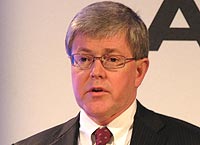U.S. InfantSee program gains traction among ODs
LONDON – The United States’ InfantSee program has been gaining momentum, Kevin L. Alexander, OD, PhD, outgoing president of the American Optometric Association, said here.

“We do believe improving a child’s quality of life starts with vision, and it starts within the first year of life,” Dr. Alexander told a group gathered for the World Conference on Optometric Globalization meeting.
About 8,000 optometrists so far have joined InfantSee, a program in which optometrists volunteer to check a child’s eyes at no cost in the first year of life, Dr. Alexander said. The latest data shows that close to 20,000 assessment forms have been entered for tracking.
“That’s only the tip of the iceberg,” Dr. Alexander said. “We’ve done an analysis with our participating doctors and we found out the average doctor sees about five infants for every assessment form they fill out. We think the number of kids seen is much greater and probably approaching more like 100,000.”
Word has been getting out about the program through mommy blogs, magazine articles and national spokesman, former president Jimmy Carter.
“It’s gaining traction. It’s gaining momentum,” Dr. Alexander told the audience. “We’re getting more and more publicity all the time.”
Part of the AOA’s challenge has been working toward increasing awareness of the program to parents.
 InfantSee growing: Kevin L. Alexander, OD, PhD, shares program highlights with world optometric leaders. Source: Passut J |
“We’re trying hard to elevate the awareness of the mothers out there to the need to have kids seen before they start school,” Dr. Alexander said. “We’re working very hard on that as an association.”
Dr. Alexander said that the last set of data collected by InfantSee indicates that one in nine infants shows a need for further evaluation after the initial exam.
“When we first started we only had about one in 14,” Dr. Alexander said. “We’re picking up more kids as this program gains momentum.”
In fact, optometrists have spotted cases of retinoblastoma, significant refractive error and congenital glaucoma in these no-cost assessments.
“We know that some of the most critical stages of neurodevelopment occur in the first year of life, so we want to be able to pick up any gross undetected vision problems that can lead to permanent vision loss,” Dr. Alexander said.
He added that the U.S. Congress has appropriated $438,000 in funding for the program.
Future plans for InfantSee include starting a Mom’s Council in which mothers get involved in giving advice to the program and adding more volunteers to the roster.
“We’d like to see about 500,000 babies annually,” Dr. Alexander said. “If we had 10,000 providers doing one infant assessment a week, we could do that. We think that would be a terrific way to get people started.”
For more information:
- Go to www.InfantSee.org.
